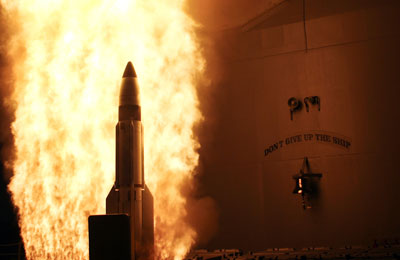Satellite shootdown overcomes bureaucracyby Taylor Dinerman
|
| Two weeks ago it seemed impossible that the MDA had the ability to quickly adapt its complex of command systems, sensors, and interceptors to perform the deed. |
Also proven wrong were those who had their doubts about the intestinal fortitude of Secretary of Defense Robert Gates. While he has not been the lighting rod for criticism and controversy that his predecessor Donald Rumsfeld was, in this case he was willing to take a stand that went directly against the left/liberal policy consensus. The arms controllers have long opposed any sort of US missile defense system or space weapons. Their opposition has been relentless and remorseless, and within the Washington establishment there were only a few military officers, political leaders, or civil servants who were willing to take the heat and fight for effective American space power. It is now evident that Bob Gates is one of those few.
The use of a missile defense system weapon to shoot down a satellite cut across several lines of authority and command, not to mention the question of money. The Joint Functional Component Command that controls the global missile defense system does not have control over the Air Force’s Space Command, which nominally has the space warfighting role. Both organizations come under Strategic Command (Stratcom), based in Omaha, Nebraska, but have traditionally not been too cooperative with each other. Indeed, the rivalry between these two organizations has been an obstacle to developing the kind of integrated space warfighting doctrine the nation needs.
This shootdown was officially not part of any new assertion of US space warfighting doctrine. According to most reports, the main reason the US acted was to insure that the frozen hydrazine onboard the wayward satellite was destroyed before it could hit the Earth. This was unlikely, but not impossible. The potential international embarrassment and legal liability that would have resulted in a worst-case situation was serious enough to overcome bureaucratic objections from inside the government.
The decision itself was not without risk. For example, the first SM-3 on board the USS Lake Erie could have failed. Even if its backup had succeeded, the system would still have been subject to withering criticism from the foes of US missile defenses. The Defense Department and the administration took a chance when they decided to target an object that their system had not been designed to hit and to do so under circumstances that were not fully under their control.
The success is a bit of a reproach to those who have long complained that the US missile defense system has not been subject to any serious testing. In fact the MDA’s “crawl-walk-run” approach to testing has been, up to now, more “crawl” than “walk”. This may have more to do with budgetary restrictions, since each test of the full system costs tens of millions of dollars at the very least, than with the technology involved.
As the story of the shootdown emerges over the next few weeks and months, one suspects that the role of the military’s personnel will turn out to have been decisive. It is a truism that any weapon is only as good as the men and women who wield it. The unclassified details of this accomplishment will be fascinating. This was the first live action test for America’s space warriors, and so far they have performed brilliantly.
There have been objections to Bob Gates’s decision to share some of these details with China and others. They claim that by giving China this data, the US is rewarding Beijing’s propagandistic temper tantrum. In fact, the US is dealing from a newfound position of strength. This demonstration of the ability of the US to match China’s ASAT, at least in very low orbit, indicates that Washington was not intimidated or paralyzed by the January 2007 ASAT test by China.
Indeed the “Blame America First” reaction, and the subsequent effort to limit aggressive US military space operations using so-called “rules of the road” has so far failed. There may be a few Democratic politicians in Washington who are still willing to push for unequal and unverifiable arms control agreements, but there are others who have no intention of giving the GOP a complete monopoly on a robust national security posture. The US may not be ready to deploy space weapons, but it has little desire to allow itself to be pre-empted in this area by others.
| The role of space assets in military operations has long been recognized as essential. The illusion that space could be kept as a sanctuary has proven resilient in the face of overwhelming evidence to the contrary. |
The ability of the US to rapidly modify an SM-3 into a weapon has been noted, as was China’s ability to modify one of their intermediate range ballistic missiles last year. The technology is not that hard to master: testing, in the traditional sense, is not required. There is no way the US could have tested its missile in an antisatellite mode in the limited time available. Others will certainly be able to do the same using either ballistic missiles or space launch vehicles.
The role of space assets in military operations has long been recognized as essential. The illusion that space could be kept as a sanctuary has proven resilient in the face of overwhelming evidence to the contrary. It will endure well past the next set military space actions, by the US or others, and well past the next administration. Eventually, like other arms control arguments of the past, such as the ones over battleship tonnage in the 1920s and 1930s, it will pass into irrelevance.
What will endure is the need for space power in all its aspects. American leaders would do well to concentrate on that, and leave both saber rattling and internationalist pipe dreams to others.
